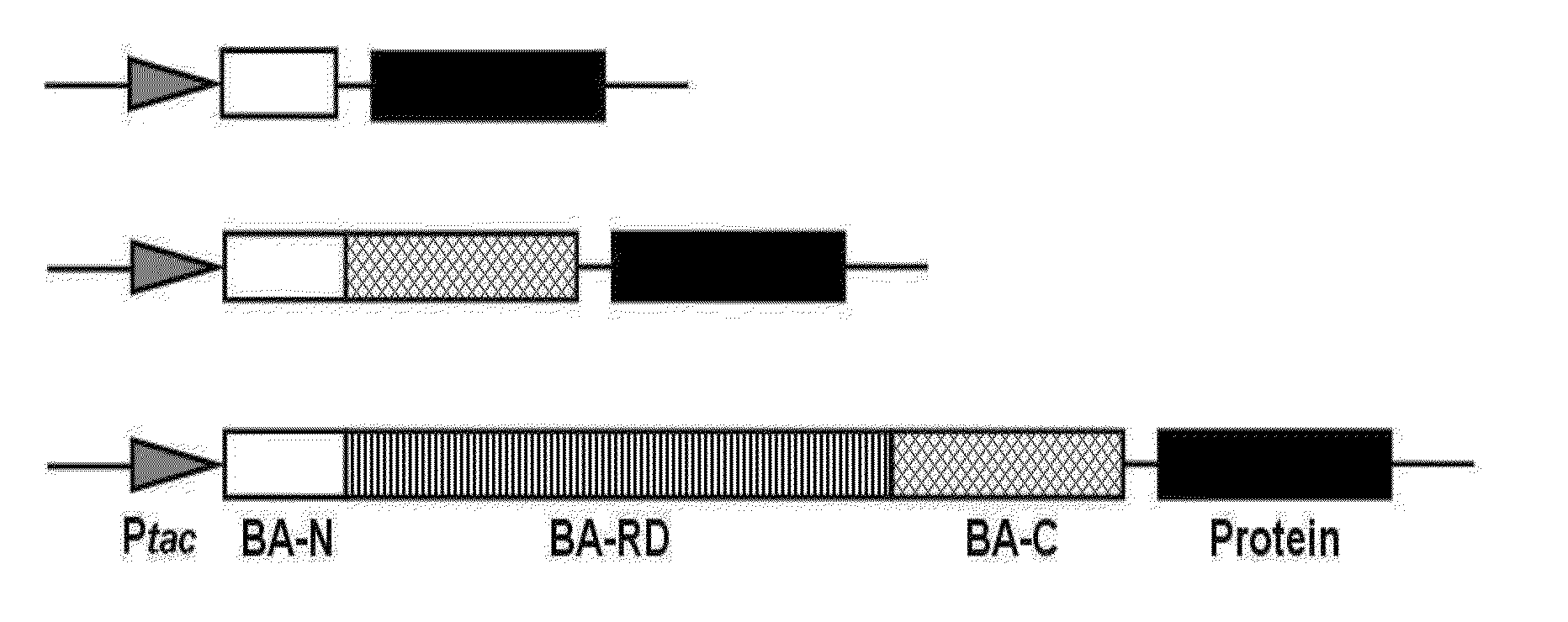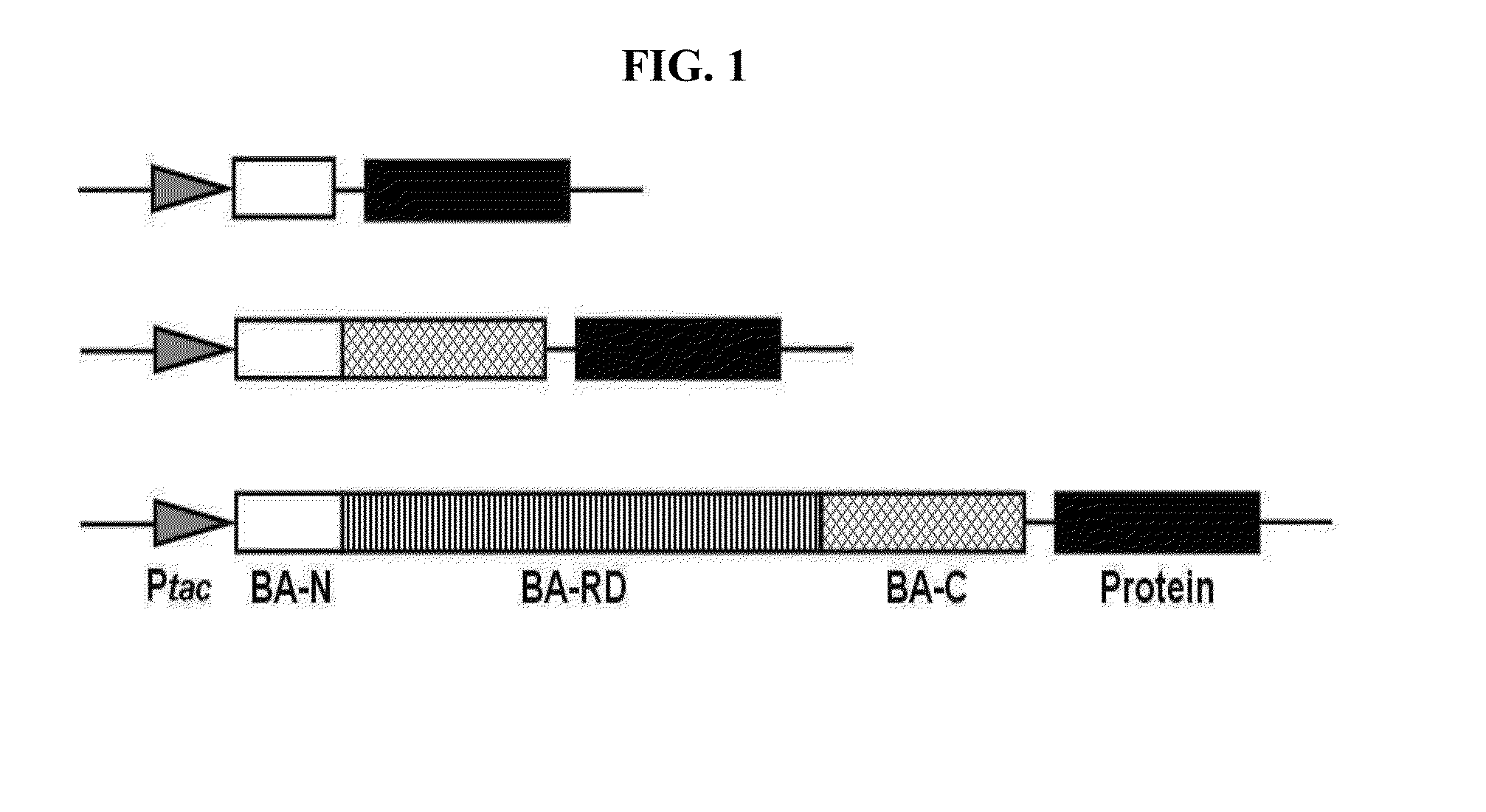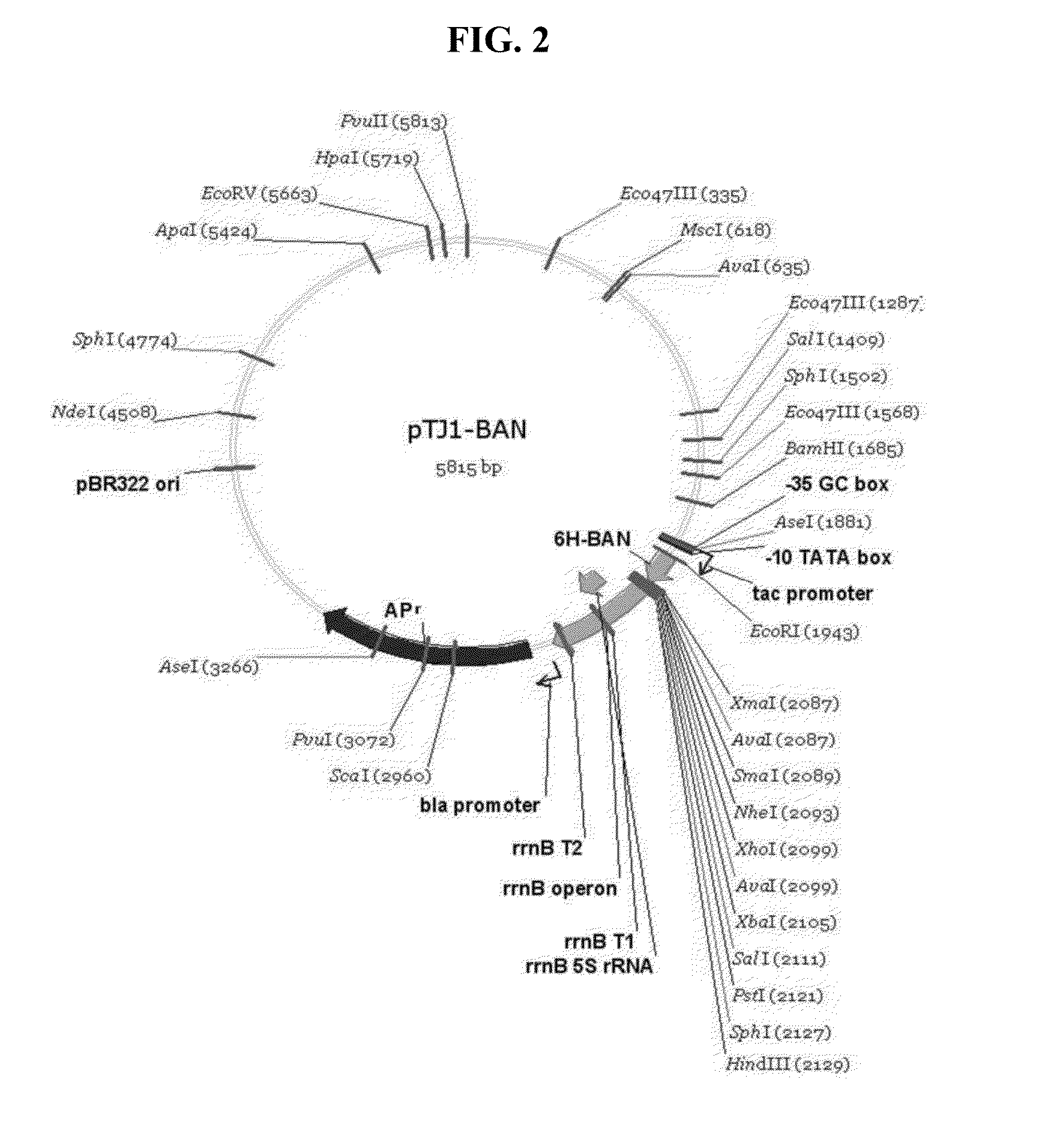Method for cell surface displaying of target proteins using Bacillus anthracis exosporium
a technology of bacillus anthracis and target proteins, which is applied in the field of expression vectors, can solve the problems of coli /i>cannot be used in this method, the size of foreign proteins which can be inserted, and the size of proteins which can be expressed on the surface of phages, etc., and achieve the effect of stably expressing
- Summary
- Abstract
- Description
- Claims
- Application Information
AI Technical Summary
Benefits of technology
Problems solved by technology
Method used
Image
Examples
example 1
Construction of Recombinant Expression Vector pTJ1-BA
[0073]In order to obtain Bacillus anthracis exosporium BclA gene, BclA gene of Bacillus anthracis RA3 (NCBI accession No. CAD56878) was synthesized to perform PCR using the synthesized gene as a template. The PCR was performed under the following conditions; 30 cycles of first denaturation at 94° C. for 7 min, second denaturation at 94° C. for 1 min, annealing at 55° C. for 1 min, extension at 72° C. for 1 min, and the last extension at 72° C. for 7 min using primers of SEQ ID NO: 4 and SEQ ID NO: 5.
[0074]
SEQ ID NO: 4:5′-GGAATTCATGTCAAATAATAATTATTC-3′SEQ ID NO: 5:5′-CGTCTAGACTCGAGGCTAGCCCCGGGAGCAACTTTTTCAATAA-3′
[0075]770 bp of DNA fragment obtained by the PCR was isolated using agarose gel electrophoresis, and digested with two restriction enzymes, EcoRI and XbaI. At the same time, plasmid pTac99A (Park and Lee, Biotechnol. Techn., 12:815, 1998) containing inducible and strong tac promoter was digested with two restriction enzymes...
example 2
Construction of Recombinant Vectors pTJ1-BAN, pTJ1-BANC and pTJ1-BAF
[0077]Bacillus anthracis exosporium BclA used as a cell surface anchoring motif has a repeated amino acid sequence, (GPT)1-8GDTGTT between the N-terminal end and the C-terminal end (Sylvestre et al., Mol Microbiol., 45:169, 2002).
[0078]2-1: Construction of Recombinant Expression Vector pTJ1-BAN
[0079]In order to examine whether only the N-terminal end can be used as a cell surface anchoring motif, each cell surface anchoring motif was designed such that they can be fused with a target protein.
[0080]For the construction of a plasmid to use the N-terminal end of BclA gene as a cell surface anchoring motif, PCR was performed under the following conditions; 30 cycles of first denaturation at 94° C. for 5 min, second denaturation at 94° C. for 30 sec, annealing at 56° C. for 30 sec, extension at 72° C. for 30 sec, and the last extension at 72° C. for 7 min using primers of SEQ ID NO: 4 of Example 1 and SEQ ID NO: 6.
[0081]...
example 3
Construction of Recombinant Expression Vectors, pTJ1-BAN-ScFv-SA, pTJ1-BANC-ScFv-SA and pTJ1-BAF-ScFv-SA, and pTJ1-BAN-Lip1, pTJ1-BANC-Lip1 and pTJ1-BAF-Lip1
[0098]As a model protein expressed on the cell surface, recombinant expression vectors, pTJ1-BAN-ScFv-SA, pTJ1-BANC-ScFv-SA and pTJ1-BAF-ScFv-SA, and pTJ1-BAN-Lip1, pTJ1-BANC-Lip1 and pTJ1-BAF-Lip1 were constructed using a fusion protein of a single chain antibody and streptavidin and lipase.
[0099]3-1 Construction of Recombinant Expression Vectors, pTJ1-BAN-ScFv-SA, pTJ1-BANC-ScFv-SA and pTJ1-BAF-ScFv-SA
[0100]In order to obtain a fusion protein gene of a single chain antibody and streptavidin, PCR was performed under the following conditions; 30 cycles of first denaturation at 94° C. for 5 min, second denaturation at 94° C. for 30 sec, annealing at 56° C. for 30 sec, extension at 72° C. for 1 min 10 sec, and the last extension at 72° C. for 7 min using primers of SEQ ID NO: 9 and SEQ ID NO: 10.
[0101]
SEQ ID NO: 9:5′-TTTACCCGGGTCG...
PUM
| Property | Measurement | Unit |
|---|---|---|
| OD | aaaaa | aaaaa |
| pH | aaaaa | aaaaa |
| pH | aaaaa | aaaaa |
Abstract
Description
Claims
Application Information
 Login to View More
Login to View More - R&D
- Intellectual Property
- Life Sciences
- Materials
- Tech Scout
- Unparalleled Data Quality
- Higher Quality Content
- 60% Fewer Hallucinations
Browse by: Latest US Patents, China's latest patents, Technical Efficacy Thesaurus, Application Domain, Technology Topic, Popular Technical Reports.
© 2025 PatSnap. All rights reserved.Legal|Privacy policy|Modern Slavery Act Transparency Statement|Sitemap|About US| Contact US: help@patsnap.com



